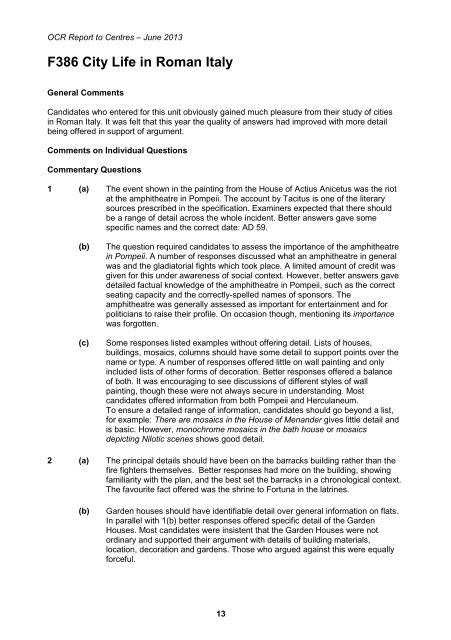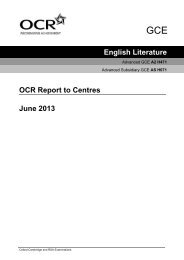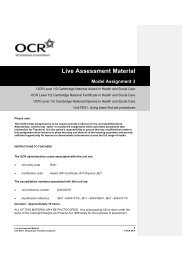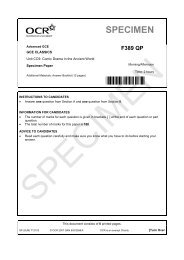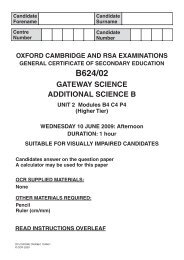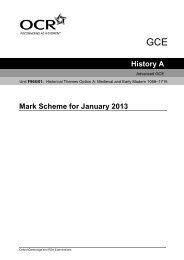Examiners' reports - June (PDF, 440KB) - OCR
Examiners' reports - June (PDF, 440KB) - OCR
Examiners' reports - June (PDF, 440KB) - OCR
Create successful ePaper yourself
Turn your PDF publications into a flip-book with our unique Google optimized e-Paper software.
<strong>OCR</strong> Report to Centres – <strong>June</strong> 2013<br />
F386 City Life in Roman Italy<br />
General Comments<br />
Candidates who entered for this unit obviously gained much pleasure from their study of cities<br />
in Roman Italy. It was felt that this year the quality of answers had improved with more detail<br />
being offered in support of argument.<br />
Comments on Individual Questions<br />
Commentary Questions<br />
1 (a) The event shown in the painting from the House of Actius Anicetus was the riot<br />
at the amphitheatre in Pompeii. The account by Tacitus is one of the literary<br />
sources prescribed in the specification. Examiners expected that there should<br />
be a range of detail across the whole incident. Better answers gave some<br />
specific names and the correct date: AD 59.<br />
(b)<br />
(c)<br />
The question required candidates to assess the importance of the amphitheatre<br />
in Pompeii. A number of responses discussed what an amphitheatre in general<br />
was and the gladiatorial fights which took place. A limited amount of credit was<br />
given for this under awareness of social context. However, better answers gave<br />
detailed factual knowledge of the amphitheatre in Pompeii, such as the correct<br />
seating capacity and the correctly-spelled names of sponsors. The<br />
amphitheatre was generally assessed as important for entertainment and for<br />
politicians to raise their profile. On occasion though, mentioning its importance<br />
was forgotten.<br />
Some responses listed examples without offering detail. Lists of houses,<br />
buildings, mosaics, columns should have some detail to support points over the<br />
name or type. A number of responses offered little on wall painting and only<br />
included lists of other forms of decoration. Better responses offered a balance<br />
of both. It was encouraging to see discussions of different styles of wall<br />
painting, though these were not always secure in understanding. Most<br />
candidates offered information from both Pompeii and Herculaneum.<br />
To ensure a detailed range of information, candidates should go beyond a list,<br />
for example: There are mosaics in the House of Menander gives little detail and<br />
is basic. However, monochrome mosaics in the bath house or mosaics<br />
depicting Nilotic scenes shows good detail.<br />
2 (a) The principal details should have been on the barracks building rather than the<br />
fire fighters themselves. Better responses had more on the building, showing<br />
familiarity with the plan, and the best set the barracks in a chronological context.<br />
The favourite fact offered was the shrine to Fortuna in the latrines.<br />
(b)<br />
Garden houses should have identifiable detail over general information on flats.<br />
In parallel with 1(b) better responses offered specific detail of the Garden<br />
Houses. Most candidates were insistent that the Garden Houses were not<br />
ordinary and supported their argument with details of building materials,<br />
location, decoration and gardens. Those who argued against this were equally<br />
forceful.<br />
13


